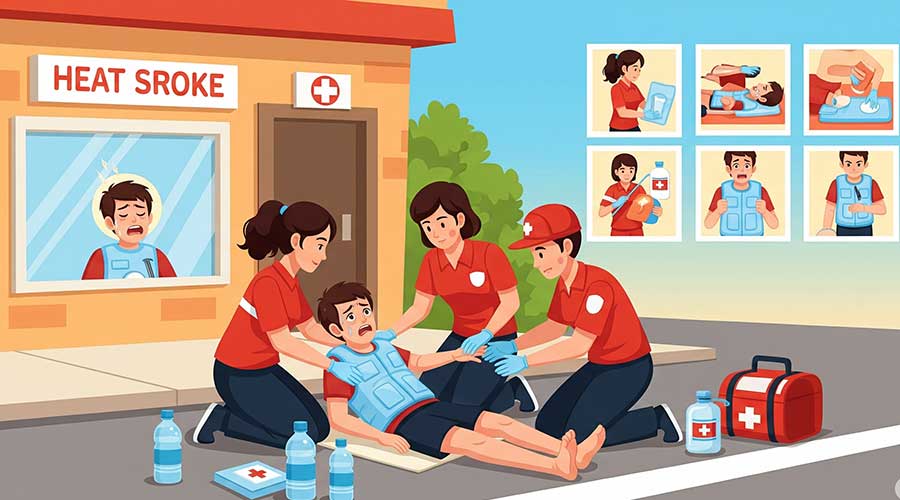This article includes a self-assessment checklist + first aid flowchart. Be sure to save and share it!

1. Heat Stroke: The Deadly Truth
Heat Stroke = Severe Heat Exhaustion: When your core body temperature rises above 40°C (104°F), it’s like being slowly cooked alive.
⚠️ Brain cells begin to die, organs like the liver and kidneys start to fail, and the blood begins to clot.
❗ The fatality rate is as high as 50%. The elderly, outdoor workers, and those with chronic health conditions are at the highest risk.
2. Self-Assessment: Recognize the Early Signs
If you notice any two of the following symptoms, act immediately!
| Symptom Type | Danger Signs |
|---|---|
| Temperature Alert | Armpit temperature > 39°C / Ear temperature > 40°C |
| Neurological Issues | Slurred speech, agitation, seizures, confusion |
| Body Collapse | Sudden cessation of sweating + dark urine (like strong tea) |
| High-Risk Indicators | Projectile vomiting / Heart rate > 160 beats per minute |
📌 Key Tip: If sweating suddenly stops, it’s a sign that the sweat glands have collapsed! Organ failure is just around the corner.
3. Golden 30-Minutes for First Aid: Every 5-Minute Delay Increases the Fatality Rate by 10%
🆘 First Aid Steps (What Family & Friends Should Do)
Important DOs:
✅ Water Temperature: 16-20°C (60-68°F) — Avoid ice-cold water!
✅ Rehydration Solution: Mix 500ml water with 1.5g salt (about half the cap of a beer bottle).
✅ On the Way to the Hospital: When transporting to the hospital, shout: “Suspected heat stroke, body temperature XX°C, patient unconscious!”
Important DON’Ts:
❌ Avoid: Pinching the person’s nose, or administering herbal remedies like “Huo Xiang Zheng Qi Shui” (which contains alcohol and accelerates dehydration).
❌ Never Give: Fever medicine (like ibuprofen—it can be toxic in heat stroke cases).
❌ Avoid: Alcohol rubs (which can induce chills, increasing heat production, and cause poisoning).
4. Preventing Heat Stroke: A Guide for High-Risk Groups
Outdoor Workers (Construction, Sanitation, Police, etc.)
- Gear: Cooling vests + wide-brimmed hats (search for “Phase Change Material Cooling Vest” online).
- Hydration: Drink 500ml of electrolyte water every hour (refer to recipe below).
- Breaks: Rest between 10 AM to 3 PM, avoid peak heat exposure.
Elderly/Chronic Patients
- Environment: Keep the air conditioner at 26°C (79°F) + monitor humidity levels (turn on the dehumidifier if > 70%).
- Daily Monitoring: Check morning urine color (light yellow = safe, dark yellow = dehydration).
- Medications: Adjust doses for hypertension/diabetes as per medical advice during summer.
Children’s Safety
- Car Safety: Never leave children alone in a car—even with the engine off, temperatures can reach 60°C (140°F) within 20 minutes!
- Sports: Schedule soccer practice early in the morning or evening, and enforce mandatory water breaks every 20 minutes.
- Clothing: Opt for moisture-wicking clothes rather than cotton (which traps heat when soaked with sweat).
5. Diet During Heat Stroke: What to Eat, What to Avoid
| Life-Saving Choices | Deadly Traps |
|---|---|
| Electrolyte Water: 1L water + 3g salt | Ice-cold beer or soda |
| Watermelon Juice + a pinch of sea salt | High-sugar milk tea/juice |
| Coconut Water (natural electrolytes) | Huo Xiang Zheng Qi Shui (contains alcohol, accelerates dehydration) |
💡 DIY Electrolyte Water: Mix 1L water + 3g salt + 10g honey + juice of half a lemon.
6. Ultimate Prevention Checklist: Save This for Quick Access
Indoor Environment: Keep air conditioning at 26-28°C (78-82°F) and humidity below 70%.
Hydration: Drink small sips of water regularly throughout the day, aiming for 1.5-2L of water daily.
Outdoor Precautions: Avoid the hottest hours, and keep a cooling mint wipe handy to refresh your neck.
Diet: Eat more bitter melon, winter melon, and loofah. Avoid fried and oily foods.
Sleep: Ensure you get 7 hours of sleep each night, and use a cooling mat in the bedroom.
7. Critical Warning Signs: Intervene Immediately
If you notice someone showing abnormal behavior under high heat (e.g., a delivery worker stumbling or an elderly person acting aggressively), take immediate action. You could be preventing a fatality!
By being aware of the signs, knowing how to react, and taking preventive measures, we can significantly reduce the risks of heat stroke and potentially save lives during extreme heat. Stay cool and stay safe!
This article is designed to provide essential information on recognizing, preventing, and responding to heat stroke. Whether you’re at home, at work, or out in the heat, being prepared is key to protecting yourself and those around you.
